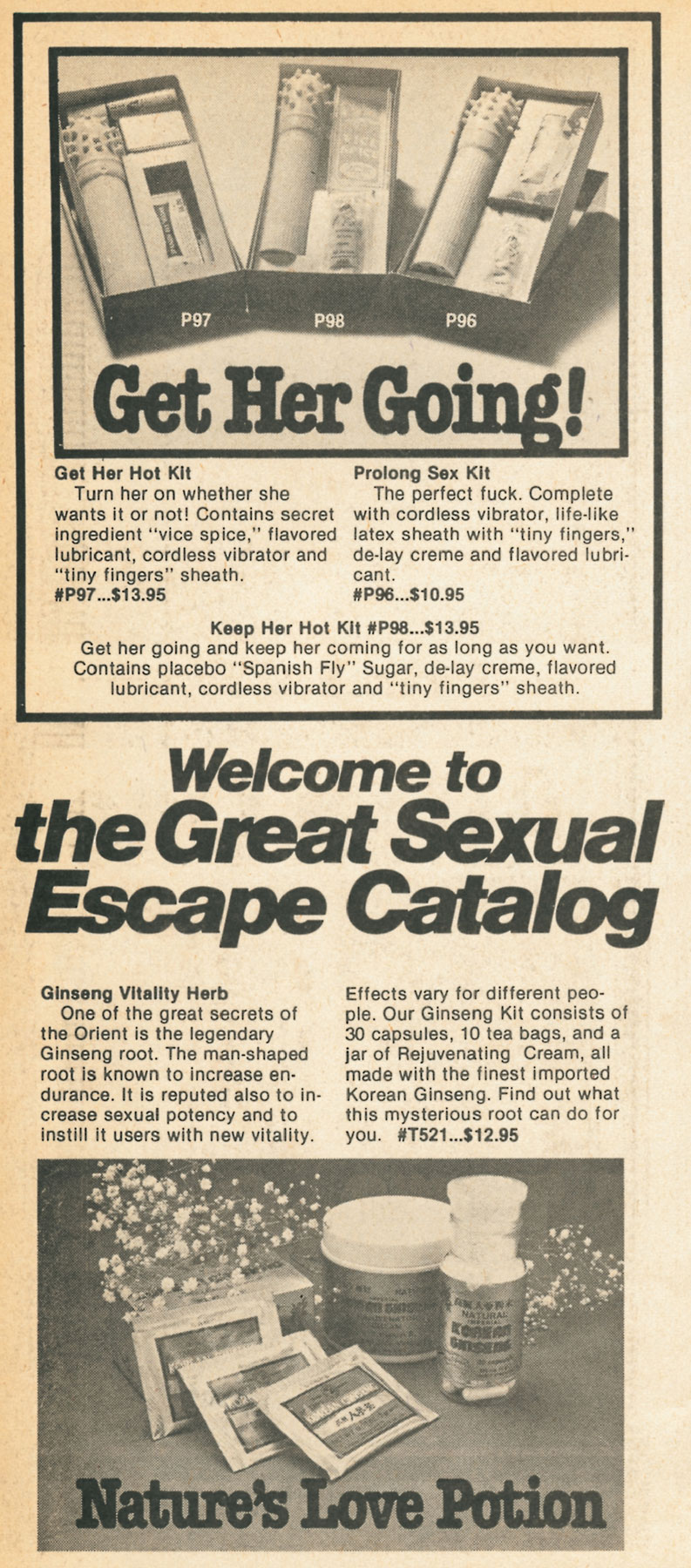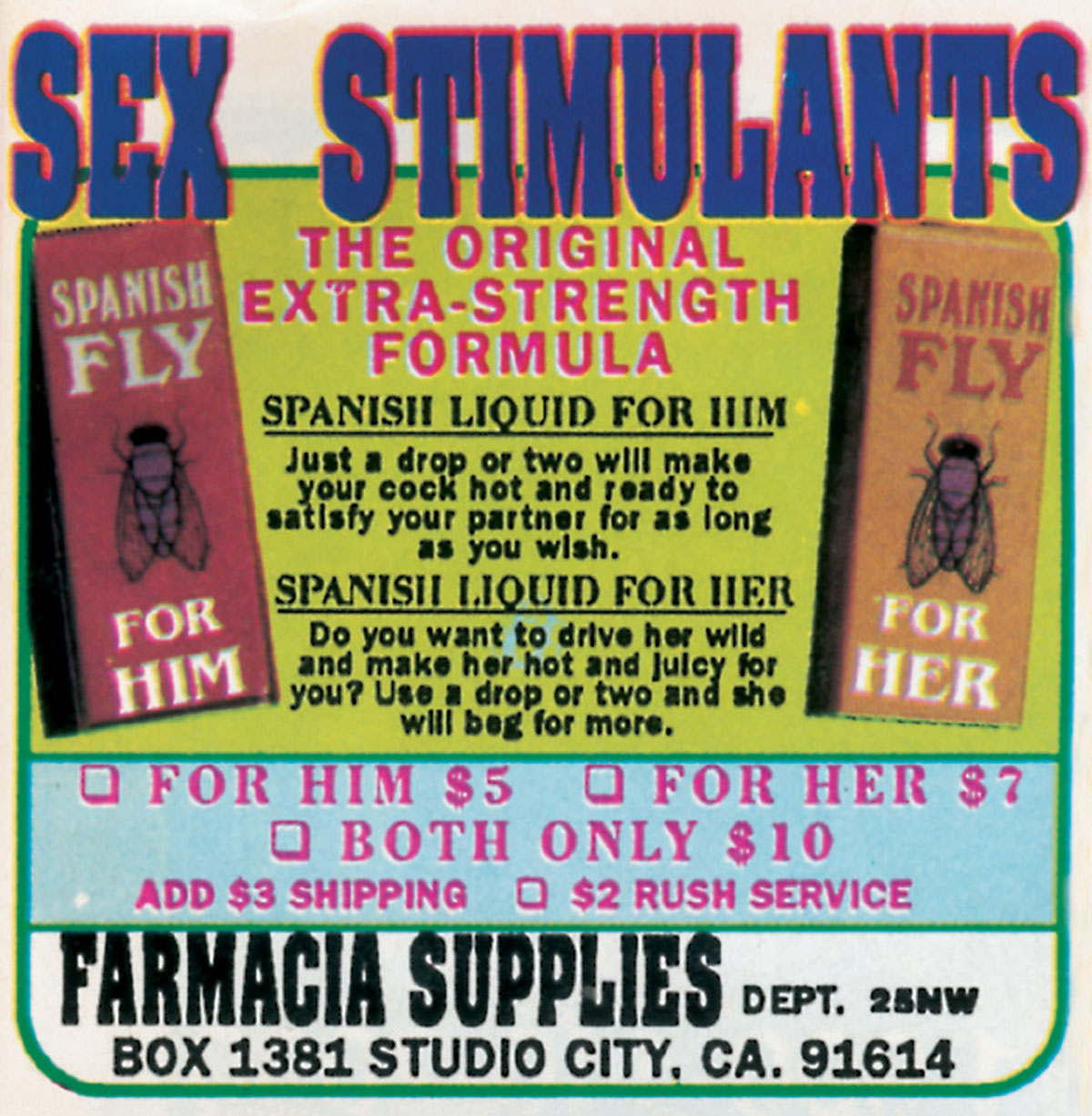Poison Eros
Anecdotes on aphrodisiacs and dose
Miranda Flower Mellis
Aphrodisiacs’ promise is fraught with danger—indeed, danger is itself an aphrodisiac. When there is sexual attraction, bodies are flooded with PEA (phenylethylamine), a molecule that speeds up the flow of information between nerve cells; the same chemical is released in life-threatening circumstances, such as combat. Physiologically, aphrodisiacs are agents that have stimulating effects upon the skin, the cutaneous nerves, or the circulation. But Eros, of course, cannot be reduced to the physiological. On the emotional plane, curiosity and hope about such agents reflect the possibility of creating desire where the specter of its nonexistence is intolerable. We assign magical qualities to others and are maddened when they do not cure our ills or fulfill our fantasies—and our approach to aphrodisiacs is analogous to our approach to love: Will I arouse my beloved? If it doesn’t work will I (want to) poison her? Both physically and metaphysically, the difference between intoxicating rush and toxic overload is often determined by just how deeply the stimulant, be it mood or mood-altering chemical, has entered the system. With the question of potency or dose, the line between potion and venom blurs. The lover’s catalogue of options telescopes to one urgent need: to resurrect sex, to concentrate or distill it into storable, ingestible, stable, and known form. We overdose, we crave a fix, or we find medicine.
Aphrodisiacs range from the ethereal to the pharmaceutical, and flower remedies, invented in the 1930s by Edward Bach, might be considered as prototypical of the former type. If the conventional, Western-medical view is that wellness and illness are solely functions of biochemical states, Bach’s elixirs operate on the principle that the universe is a flux of energy fields and forces that give rise to our experience of matter. Flower remedies are deployed with the understanding that reality and consciousness are changed by our participation. Indeed, the nascent field of psychoneuroimmunology documents the mind’s ability, via the nervous system, to affect the immune system. Flower remedies address this interface between mental, emotional, and physical health, and are said to catalyze change at the cellular, emotional, and psychic levels. They are extracted by replicating the way that nature makes dew. Originally, Bach collected dews directly from the plants; later, he began to gather blossoms and steep them in crystal bowls of spring water set in the morning sun. All remedies are made in the open air in the plants’ habitats and are matched with specific symptoms through intuition and experiment. Infusions of flowers such as bougainvillea, carnation, and hibiscus are recommended to “unlock sexual grace.” In contrast to the target-and-shoot approach of pharmaceuticals aimed at the production of socially prescribed performance, flower remedies harmonize multiple subtle elements. Unlocking sexual grace, then, could manifest as abstinence, sublimation, or fornication, depending upon what is needed for dynamic, integrative balance.
Bach’s theories drew upon and modified those of Samuel Hahnemann (1755–1843), the originator of modern homeopathy, whose dictum was that “like cures like.” Bach suggested, rather, that like repels like.
We no longer fight disease with disease, no longer oppose illness with the products of illness: no longer attempt to drive out maladies with such substances that can cause them: But on the contrary, to bring down the opposing virtue which will eliminate the fault.[1]

Faults of interior chemistry, then, are opposed by the medicine/poison of the attracted opposite. Desire battens on absence, while aphrodisiacs are associated with plenitude upon demand: “Desire is to lack what one has, and to give what one does not have: a matter of supplements, not complements.”[2]
In such a visionary/erotic economy, consider the remedy as compared with the drug: A remedy vibrates micro/cosmically; a drug bombs. The basic distinction between the two forces is dose. The more physically dense the symptoms, the higher the required dosage of the cure, since a drug is always dense with dosage. For etheric, emotional, or psychic symptoms, smaller dosages will be appropriate—therefore the efficacy of infusions, droplets, tinctures. The solutions are internal to the system, and need only be awakened. Too much of a good thing defines both love and medicine gone awry.
And yet, the promise of unlimited happiness perhaps defines the desire for desire’s essences, the urge to get in the groove through love’s narcotics. Archaic (monkey balls), pharmaceutical (Viagra), and mundane household aphrodisiacs (pine nuts, ginger, honey) are eaten to stimulate circulation—of blood and fluids, moods, and aesthetic and sensory sensitivity. Some aphrodisiacs, in fact, work like placebos. Placebo = magic potion, efficacious by way of allusion/illusion. The etiology of the placebo effect could be read to suggest that emotions and metabolic states interpenetrate all along the scale, echoing proximately to the word’s genealogy: The Latin placebo, “I shall please,” derives from Catholic vespers for the dead, and in medical contexts, implies the doctor’s effort to please the patient. The implication is that the placebo is a vehicle for faith—in the doctor, in the medicine, in spiritual healing, etc. Any object—an amulet, a sugar pill, a stolen lock of hair—invested with emotion and thought (belief) will refract through the body, where every cell has a receptor listening for information and intention.
Where aphrodisiac environs are sites of multisensory ambiance—excitement is provoked through perception—ingested aphrodisiacs double as chemical and insinuating agents of arousal. Where the will is lacking to create feasts, intimacy, and atmospheres, there are insta-aphrodisiac/poisons, like the much-touted Viagra, the ubiquitous alcohol, or the less easily acquired Spanish Fly, all of which link passion with toxicity. Chemical toxicity creates a physiological delay; outcomes are not always in alignment with intentions, and before one can discern the meaning or quality of an event colored by extra-systemic poisons, one must detoxify. (Emotional toxicity works much the same way. In either case, it seems, detox requires abstinence.)
Viagra, which was initially created as a cardiac medicine, is obviously genitally focused—the heart/cock link and the corollary implication of an emotional component to sexual dysfunction has not, however, been encouraged by the advertising of the drug. If sexual relationships are performative, what do we perform in exhibiting the hard-on as our cultural symbol of erotic health? Passion is brought to heel and made to produce. At Burning Man (a yearly anarcho-techno-pagan gathering in the Nevada desert) there are circle jerks where men take ecstasy and Viagra at once. In its appropriation of the alleged penile panacea, the priapic circle jerk devolves the pharmaceutical industry’s latest commodity to the status of banned substance, thereby exposing the distinction between an illegal aphrodisiac and one people buy stock in as blurry, if not laughable. (Viagra can cause transient blue-green blindness, light sensitivity, headaches, and upset stomach, while ecstasy depletes serotonin, stimulates involuntary muscular activity, and has a tendency to interact badly with other substances.[3] Both can be fatal.)

Many aphrodisiacs enact this Eros/Thanatos connection. Spanish fly, the most notorious edible aphrodisiac, is also most dangerous—it is a poison that, improperly used, burns the mouth and causes infections, and even death. Spanish Fly is actually a urinary-tract irritant called cantharidin, derived from the Meloid beetle, which excretes cantharidin to wage chemical war on threatening predators. Absinthe, perhaps the most famous alcoholic aphrodisiac and hallucinogen, whose phantasms fueled the Impressionists, is an extract of wormwood (a palliative which Christ was offered, but refused, during his passion). Rich in toxic compounds, absinthe in habitual application can result in blindness and nerve injury. (The French government felt absinthe had sapped the people’s will to go to war and so banned the “green fairy” in 1915, though it has recently made a niche-market comeback in the US)
The extremity of the hallucinogenic experience shares topologies with creativity and sex, which in turn mirror warfare and self-defense. Hallucinations, like visions of perfect love, subside, leaving temporal wounds: dead cells and emotional scars. Zones of exchange, of dissolution of interior and exterior, imply ecstatic or agonizing breaches, which surpass reality, by which we are inscribed and initiated. Perhaps, then, the urge to inflict pain on oneself, to drink to excess or to scar and tattoo in the aftermath of wounds to the heart, comes from a homeopathic instinct to be cured of pain with pain. Might a small dose of indifference chase out indifference, or a potent taste bring potency? Romans ate animal genitalia, crediting the Doctrine of Similarities with the power to intensify virility; in the same way oysters and pomegranates lure love by suggesting female genitalia, while the zinc in oysters also increases fertility in men. The narcissism of attraction and procreation works by a similar logic. I multiply myself by ingesting you.
Gender-specific marketing remains crucial to the discourse of the aphrodisiac. A website advertising pheromones instructs: “click here if you want to attract women” and “click here if you want to attract men.” Were I in the market for pheromones, I wouldn’t know which to click. The gender-dysphoric are abjected from this market of desire, although there are some gender-neutral turn-ons that purport to arouse anything with a circulatory system, and some of the most basic, tried-and-true aphrodisiacs have little gender-coding. Cocoa, a central nervous system stimulant, produces an amphetamine-like chemical that the body produces naturally in both men and women when we’re in love. Scents, colors, chocolates, flowers—accoutrements for sweet emotion and aesthetic delight—are allied with an androgynous, diffuse sensuality. Certain other herbal preparations traditionally connote female arousal. Datura, a potentially deadly plant (which, along with other psychotropic flora, was painted repeatedly by Georgia O’Keefe) is alternately called Devil’s Apple or Mad Apple (with hints of Eve’s lasciviousness), Jimson Weed (after Jamestown, Virginia, where settlers came upon it), Witches’ Thimble, or Ghost Flower. Datura was a key ingredient in witches’ flying mixture, along with other plants containing alkaloids, like henbane. The ointment was rubbed on broomsticks and the witches would slide their labia along the stick; the poison entered the blood stream through the mucus membranes and the witches felt soaring sensations. Masturbatory sexual pleasure, mediated by apparatus and drug, implies the supplement as mirror, the self as a potential other lover. The masturbating, tripping witch is the voyeur of her own self-seduction.


Datura, like its sister nightshade belladonna, dilates the pupils and has thus been used to simulate sexual arousal, which also causes the eyes to widen. As witches know, the seeds are hallucinogenic, and in the Middle Ages, royalty would sometimes spike peasants’ beer with them, causing the drinkers to go mad temporarily, making fools of them for sport. Nightshades affect the pineal and hypothalamus glands, allegedly causing clairvoyance and the ability to speak in the language of the gods (or the poesis of anthropomorphized plants). Victims of belladonna poisoning act and are sometimes incorrectly diagnosed as psychotic. In homeopathic doses, however, belladonna cures what it causes. It can induce, but also treat tachycardia or irregular heartbeat; it counteracts poisoning by alcohol and tobacco, and is used as an antispasmodic. Datura has been applied as an antidote for nerve gas and pesticide poisoning. It also cleans up toxic waste (as does milk thistle), sometimes spontaneously appearing where toxins have suffused the land.
The homeopathic imagination doses on its disease/double to avoid being subsumed by alien forces. The generic can’t survive the strangethe bricoleur-infant instinctively puts the world in its mouth and thereby disarms it. Becoming like the toxin, generating something monstrously strong or ethereally subversive, we heal the disease by ingesting its mystery; when desire is defeated, by impotence or alienation, aphrodisiacs offer tempting surrogates. Deferring, sublimating, and supplementing, we dose ourselves as exactly as we can, sometimes exacerbating the original longing—which if not satiated or released, is only rerouted. The depth of meaning we derive from kinesthetic overstimulation in sexual union may not be known until it wanes or disappears. (“Love, any devil else but you.”) Then, the almost inhuman urgency of our libidos reconnects us to the organic, mindless energies of stems, roots, flowers, drugs, drops, meats. But we suffer cognitive power failures regarding the compost pile for which most of our crude love-you-forevers are destined. We forget pain (that of childbirth, for example) but we don’t soon forget the nausea of poisoning. Or pleasure.
- Edward Bach, “Ye Suffer From Yourselves,” in Collected Writings of Edward Bach, ed. Julia Bernard (Hereford: Bach Educational Programme, 1978), p. 113.
- Roland Barthes, A Lover’s Discourse, trans. Richard Howard (New York: Hill and Wang, 1978), p. 226.
- Dr. Joseph Mercola, www.mercola.com/1998/jun/15/viagra.htm [link defunct—Eds.].
Miranda Flower Mellis, formerly an aerialist with the Turnbuckles, is a writer from San Francisco who has just moved to Providence to begin the graduate writing program at Brown University.
Spotted an error? Email us at corrections at cabinetmagazine dot org.
If you’ve enjoyed the free articles that we offer on our site, please consider subscribing to our nonprofit magazine. You get twelve online issues and unlimited access to all our archives.